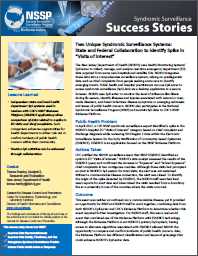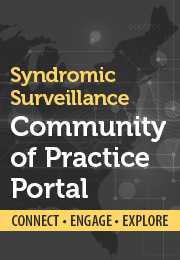Success Stories
CDC’s National Syndromic Surveillance Program (NSSP) is a collaboration between CDC and local and state health departments that collect, analyze, and share patient encounter data from emergency departments, urgent and ambulatory care centers, and inpatient healthcare settings, as well as pharmacy and laboratory data. These data are used to improve local, state, and national situational awareness and enhance responsiveness to hazardous events and outbreaks.
The Syndromic Surveillance Community of Practice works to improve
- Data representativeness;
- Data quality, timeliness, and utility;
- Practice of syndromic surveillance; and
- Use of syndromic data for public health action and response.
Featured Success Story
 Two Unique Syndromic Surveillance Systems are Optimized
Two Unique Syndromic Surveillance Systems are Optimized
Collaboration can be helpful in ruling out or confirming public health incidents. The New Jersey Department of Health demonstrates how independent state and local health departments can use syndromic surveillance systems in tandem with the BioSense Platform to enhance routine syndromic surveillance activities.
Success Story Template
The NSSP Success Stories Template (PDF) will help guide you as you create your syndromic surveillance program’s success story.
Please email your completed success story to support@icf-biosense.atlassian.net.
2009–2012 Success Snapshots
2012 Dengue Detection Project in Florida and Hawaii
- Data from BioSense were used to enhance surveillance for dengue infection by identifying instances of persons seeking care at VA facilities who showed dengue-like signs and symptoms, such as fever, rash, headache, and unexplained bleeding. Health officials in Florida and Hawaii, the VA, and in CDC’s Dengue Branch were notified when a possible dengue case was identified.
2010 Deepwater Horizon Gulf Oil Spill
- During the response to the Deepwater Horizon oil spill in the Gulf of Mexico, BioSense helped CDC monitor for illnesses, disease outbreaks, or harmful effects of exposure to oil or clean-up chemicals. In coordination with state and local jurisdictions in Alabama, Florida, Louisiana, Mississippi, and Texas; and the VA and DoD, BioSense worked with the CDC Emergency Operations Center to monitor for 21 conditions, including several mental health conditions. BioSense helped produce daily situation awareness reports for state and local responders in affected states.
2009–2010 H1N1 Flu Pandemic
- From the beginning of the H1N1 flu pandemic in April 2009, BioSense provided vital information from participating U.S. civilian hospital emergency departments, laboratories, and pharmacies to the CDC Emergency Operations Center, CDC’s Influenza Division, and state and local public health departments. BioSense helped CDC monitor the distribution, severity, and variability of flu-related emergency department visits across the country. This ongoing situation awareness helped CDC then make decisions about immunization recommendations, school and public building closures, and other response steps.
- Page last reviewed: August 1, 2017
- Page last updated: August 1, 2017
- Content source:




 ShareCompartir
ShareCompartir